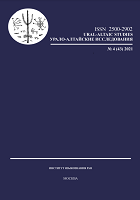ИМЕННОЕ СОЧИНЕНИЕ И КОМИТАТИВНЫЕ КОНСТРУКЦИИ В СЕВЕРНЫХ ДИАЛЕКТАХ МАНСИЙСКОГО ЯЗЫКА
NOMINAL COORDINATION AND COMITATIVE CONSTRUCTIONS IN NORTHERN MANSI
Author(s): Irina A. Khomchenkova, Daria O. ZhornikSubject(s): Theoretical Linguistics, Morphology, Lexis, Finno-Ugrian studies
Published by: Институт языкознания Российской академии наук
Keywords: comitative; coordination; dual; noun morphology; Mansi; Ob-Ugric languages; Finno-Ugric languages;
Summary/Abstract: The paper describes coordinating and comitative constructions in Northern Mansi. It examines the following coordinating markers: the additive item os ‘ADD’, the lexeme tuwol ‘then’, and the marker -y ‘DU’ as well as the comitative postposition jot ‘COM’ and the instrumental marker -(a)/, -to/. It shows that the items os and tuwol do not impose restrictions on the number and part-of-speech attribution of conjuncts and can coordinate nouns with modifiers. In some idiolects, the basic NP coordinating strategy is to use tuwol, while os is more restricted and primarily used as an additive particle. The double dual marker can only coordinate two NPs without modifiers. Its main function is to coordinate symmetrical pairs denoting objects that often occur together (e.g., mother and father, daughter and son). The postposition jot is used in the genuine comitative constructions as well as in the actant, coordinating, and inclusory constructions. In some idiolects, it is also used in copredicative constructions. The distribution of the instrumental case marker in the comitative function is very limited: it is only used in coordinating and inclusory constructions. In this case, it can be preceded by the dual possessive marker, which refers to both NPs. Furthermore, unlike the postposition jot, the instrumental case marker cannot be attached to pronouns. In coordinating comitative constructions, these markers can coordinate less symmetrical pairs denoting objects that often occur together (for example, mother and daughter).
Journal: Урало-алтайские исследования
- Issue Year: 2021
- Issue No: 04 (43)
- Page Range: 124-148
- Page Count: 25
- Language: Russian

